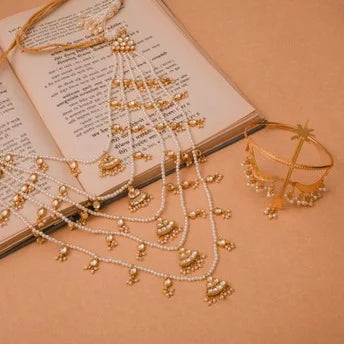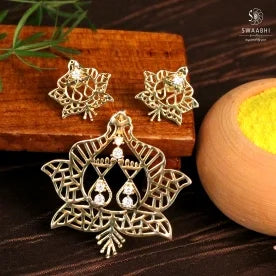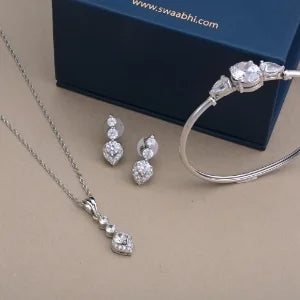
Bharatmuni’s Drama Science
In ancient Bharat, many Rishis/ Munis wrote various books(Granthas) on various subjects like Surgery, Mathematics, the Responsibilities of King, etc. Among these Granthas, one very important Granth is “Natya Shastra written by Shri Bharat Muni. It is known as Bharat Muni’s Natya Shastra. Natya Shastra was written in say around 500 BC in the Sanskrit Language by Bharat Muni. This Grantha is the earliest literature on Music and Drama. It includes 6000 couplets and has 36 chapters.
The title is formed of 2 Sanskrit words – Natya and Shastra. Natya means Drama, a combination of the act, dance, and music while Shastra means science. This Grantha focuses on dance and drama with music aids. In this book, Bharat Muni discussed every part of drama like structuring play, acting techniques, costumes and makeup, music and musical instruments, etc.
The second important part of Aharyabhinaya(dressing/makeup sense) is ornaments. These are glamorous and worn in such a way that they should make the body attractive. These ornaments make the body more appealing and glamorous. The ornaments include all the external elements that adorn the body.
If we classify these different things, we can notice these 3 things that become ornamental. Either they can be diamonds, pearls, gold, silver, or they can be different kinds of flowers, or they can be different kinds of clothes. Out of these, the names of various gold and pearl ornaments for men and women are not even known today. But along with the list of jewelry, the description of where it used to put it on the body, we can guess what kind of jewelry you had in the past.
Chudamani is an ornament worn by men on their heads. Although it is not possible to say exactly what kind it would be, according to what is described in Sanskrit literature, a gem-studded chudamani was worn in the center of the head. Bharat muni suggested men wear 3 ornaments around their necks, they are Mal, Harshak, and Sutra. The exact meaning of Mal is hard to explain.
Harshak is a gold ornament that is as stiff and round as a hansoli and Sutra seems to be an ornament like a modern gold gofa. The ornaments worn by men on their fingers were curls and simple or engraved rings.
Keyur and Angad were ornaments to be tied in a penalty. Three-layered ropes were adorning the men’s breasts. The long ropes were called Dehabhushan. The two ornaments are said to be Taral and Sutrak for men to wear on the waist.
The Taral is like a belt and its noose is encrusted with jewels, while the Sutrak is woven together by different heads like an ornamental gofa. Both Kundal and Mochak were ornaments for wearing in the ears. Kundal used to be inserted into the earlobe while Mochak into the middle of the earlobe.
Now let’s look at the ornaments that Bharata said for women. Women used to wear ornaments called “Padapatra”. At the toes, they used to wear colored rings with the name “Tilak”. The three ornaments worn by women are Nupur(anklets), kinkini, and Ghantika(bells).
Nupur should be Painjan and Kinkini should be Toradya. A Ghantika(bells) is a piece of beaded ornament made of fine beads. In this way, Jaal(nets) and Katak(cuts) were also used to adorn the soles of the feet.
The Jal was like tricks and the hairs were called Katak. Currently, Marwaris wear salsa chains at the waist. In the past, women used to tie Kanchi, Mekhla, Rashna, and Kalap on their waists. Out of these, Kanchi was in a single layer and Kalap was in 25 different layers. Haras had eight to a hundred sirs(layers). Bharat mentioned the hara’s layers were varied from eight to a hundred. Women wore different types of necklaces on their breasts.
Ladies used to wear many types of necklaces. Muktavali means pearl necklace, Vyalpankti means an ornament twisted like a sari(layer), Manjiri means an ornament of fine beads, Ratnavali means set of gems, Ratnamala and Sutraka means a gold goof – these were ornaments around the neck. The women used to leave various beads on their backs.
The engraved rings were worn on the fingers, the conch shells with the name Hastidanti bangles, the ivory bracelets called “Jave”, and the leaf palms with the name “Anshopeetak” were worn on the wrists. The two ornaments worn on the armrest are the “Angad” and the ring-like ornament is the “Valaya”. Tilak and Patralekha are the ornaments used on the forehead(Gandasthala). Patralekha means drawing lines with the help of Chandan and musk on the forehead. “Karnika”, “Patrakarnika”, “Aapekshuk”, “Karnamudra”, “Dantapatre” and “Karnapoor” are considered as the earring ornaments.
Ladies used to wear “Tilak” on their foreheads and there was another ornament worn on the eyebrows like a “Kusumaguchch” tied to the head. There many other ornaments like “Pash”, “Shikhajal”, “Khandapatra”, “Chudamani”, “Makarika”, “Motyanchi jaali” and “Gavakshika”. Bharat has not stated any ornament to wear on the nose or inside the nose. This indicates that any Shloka may have been misplaced or the nose ornaments were introduced and popular after Bharat muni’s era. It is difficult to say that only that shloka is not found rather than that the probability of not wearing the nasal ornaments at that time is more.
Bharat muni has categorized 4 types based on the ornaments wearing methods like “Aviddhya”, “Bandhaniya”, “Aakshepya” and “Aaropyak”. The ear-piercing ornaments which are put in the ear like a ring are called “Aveddhya”, The ornaments like Angad on the arms and “Rashan” on the waist are called “Bandhaneey”(binding), the ornaments worn on the feet like Nupur are “Kshepya” and the ornaments worn on the body from the upper body like necklace are termed as “Aaropyak”.
Bharata has provided 5 types of flower arrangements as “Veshtit”, “Vitat”, “Sanghatya”, “Tepit” and “Pralambit”. More explanation about how these types are introduced by the Bharata is specified by Abhinavgupta. As per his explanation, “Veshtit” means a bunch of flowers wrapped in green grass, leaves, etc. If they are tied to each other with different garlands, it is called “Vitat”. If the flowers were tied with rope horizontally and twisted in such a way that their stalks would not be visible, it was called Sanghatya.
A simple straight chain is or necklace comes under the category of “Pralambit”. The main intention was to adorn the body and become more attractive in the community with the help of these types of ornaments and jewelry make-up. Sometimes it feels surprising why Bharat muni was not concerned about wearing “Gajara” or using “flower nets” to make the difference. But considering all the above scenarios it is clear that ladies used to enjoy their ornaments in their era and the type of ornaments evolved as time changed.



 Whatsapp Us!
Whatsapp Us!